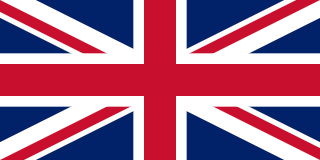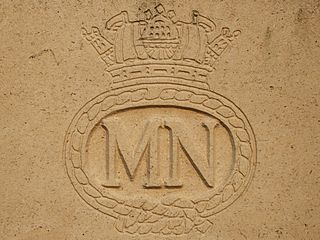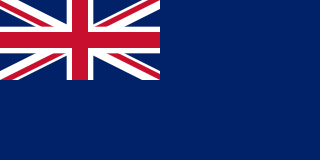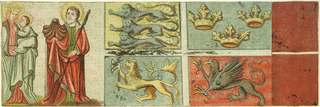The Union Jack , or Union Flag, is the flag of the United Kingdom.
Contents
Union Jack may also refer to:
- Union Jack of Norway and Sweden, a navy jack and consular flag (1844–1905)
- Jack of the United States, a navy jack
The Union Jack , or Union Flag, is the flag of the United Kingdom.
Union Jack may also refer to:
Blitz, German for "lightning", may refer to:
Crusader or Crusaders may refer to:
Morning Star, morning star, or Morningstar may refer to:
Olympia may refer to:

The Union Jack or Union Flag is the de facto national flag of the United Kingdom. The Union Jack was also used as the official flag of several British colonies and dominions before they adopted their own national flags. The flag continues to have official status in Canada, by parliamentary resolution, where it is known as the Royal Union Flag. However, it is commonly referred to in Canada as the Union Jack.

An ensign is a maritime flag that is used for the national identification of a ship. It is the largest flag and is generally flown at the stern (rear) of the ship while in port. Depending on the ship's origin, it may sometimes be identical with a jack on the bow of the ship when in a port. Jacks are more common on warships than on merchant ships.

The flag of Hawaii was first adopted in the early 19th century by the Hawaiian Kingdom and continued to be used after its overthrow in 1893. It is the only U.S. state flag to feature a foreign country's national flag—that of the Union Jack—which commemorates the British Royal Navy's historical relations with the Kingdom of Hawaii, and in particular the pro-British sentiment of its first ruler, King Kamehameha I.

The flag of Scotland is the national flag of Scotland, which consists of a white saltire defacing a blue field. The Saltire, rather than the Royal Standard of Scotland, is the correct flag for all private individuals and corporate bodies to fly. It is also, where possible, flown from Scottish Government buildings every day from 8:00 am until sunset, with certain exceptions.

In British maritime law and custom, an ensign is the identifying flag flown to designate a British ship, either military or civilian. Such flags display the United Kingdom Union Flag in the canton, with either a red, white or blue field, dependent on whether the vessel is civilian, naval, or in a special category. These are known as the red, white, and blue ensigns respectively.

The national flag of the United Kingdom is the Union Jack, also known as the Union Flag.
Marvel may refer to:

The British Merchant Navy is the collective name given to British civilian ships and their associated crews, including officers and ratings. In the UK, it is simply referred to as the Merchant Navy or MN. Merchant Navy vessels fly the Red Ensign and the ships and crew are regulated by the Maritime and Coastguard Agency (MCA), a specialist agency of the UK Department of Transport. British merchant ships are registered under the UK or Red Ensign group ship registries. British Merchant Navy deck officers and ratings are certificated and trained according to STCW Convention and the syllabus of the Merchant Navy Training Board in maritime colleges and other training institutes around the UK.

The Blue Ensign is a British ensign that may be used on vessels by certain authorised yacht clubs, Royal Research Ships and British merchant vessels whose master holds a commission in the Royal Naval Reserve or has otherwise been issued a warrant. Defaced versions with a badge or other emblem are used more broadly; in the United Kingdom by authorised government or private bodies; and internationally by nations or organisations previously a part of the British Empire.

A maritime flag is a flag designated for use on ships, boats, and other watercraft. Naval flags are considered important at sea and the rules and regulations for the flying of flags are strictly enforced. The flag flown is related to the country of registration: so much so that the word "flag" is often used symbolically as a metonym for "country of registration".

The White Ensign, at one time called the St George's Ensign because of the simultaneous existence of a crossless version of the flag, is an ensign worn on British Royal Navy ships and shore establishments. It consists of a red St George's Cross on a white field, identical to the flag of England except with the Union Flag in the upper canton.

A jack is a flag flown from a short jackstaff at the bow (front) of a vessel, while the ensign is flown on the stern (rear). Jacks on bowsprits or foremasts appeared in the 17th century. A country may have different jacks for different purposes, especially when the naval jack is forbidden to other vessels. The United Kingdom has an official civil jack; the Netherlands has several unofficial ones. In some countries, ships of other government institutions may fly the naval jack, e.g. the ships of the United States Coast Guard and the National Oceanic and Atmospheric Administration in the case of the US jack. Certain organs of the UK's government have their own departmental jacks. Commercial or pleasure craft may fly the flag of an administrative division or municipality at the bow. Merchant ships may fly a house flag. Yachts may fly a club burgee or officer's flag or the owner's private signal at the bow. Practice may be regulated by law, custom, or personal judgment.

Following the establishment of the Irish Free State, three deep water Treaty Ports at Berehaven, Spike Island, and Lough Swilly were retained by the United Kingdom in accordance with the Anglo-Irish Treaty of 6 December 1921.

The ensign of the United States is the flag of the United States when worn as an ensign. International maritime law—see International Treaty on Law of the Sea, articles 91 and 92—provides that vessels have a "national character" and thus should display a flag (ensign) that corresponds to this national character, especially when in international or foreign waters. Vessels that are formally documented under the federal vessel documentation act, vessels owned by government bodies in the United States, and vessels in the U.S. military unquestionably have U.S. national character, and thus properly hoist a U.S. ensign to show their national character. Vessels that are numbered by the states and small, non-registered craft owned by U.S. citizens and not registered in other countries may also hoist a U.S. ensign to show their national character.

There are many customs and traditions associated with the Royal Navy of the United Kingdom. Many of these traditions have carried on to other Commonwealth navies, such as Canada, India, Australia and New Zealand. These include formal customs such as separate crests associated with ships, ensigns and fleet reviews. There are also several less formal customs and traditions, including Naval slang commonly referred to as Jack Speak and the traditional games of Uckers and Euchre.
Titania may refer to: